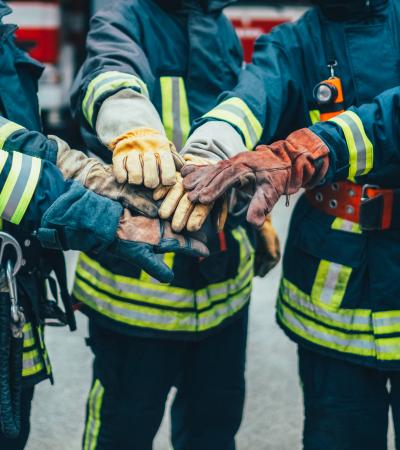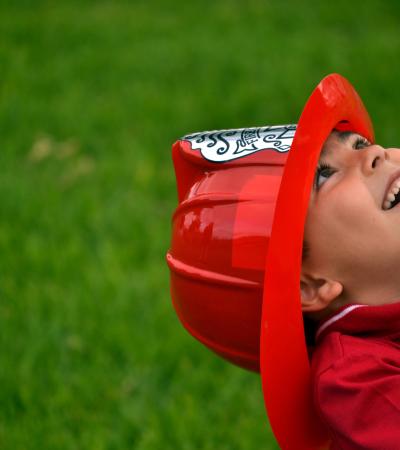The Illinois Fire Service Institute Library (IFSI Library) in Champaign, Illinois, provides fire and emergency library and information assistance to the Fire Institute’s instructional staff, students and over 1,000 Illinois fire departments and 42,000 Illinois firefighters. Founded in 1990 by Head Librarian Lian Ruan, the library provides unique resources to a highly specialized community.

Through ALA’s American Rescue Plan: Humanities Grants for Libraries, the library is creating the Children Fire Safety Literacy Reading and Discussion Program. The program, which can be implemented by Illinois fire departments, uses history, biography and fiction to teach children in their community about fire safety. The library is currently cataloging 80 new books that can be loaned out to fire departments statewide for firefighters to read and discuss with youth.
I spoke with Ruan and Reference and Training Librarian Diane Richardson about their unique institution and how their new reading program will help spread fire literacy throughout their state.
Lian, tell me about how you started the library and how you and your team have made it what it is today.
Ruan: Back in 1990, the library was established as an in-house resource for instructors. There were only 10 full-time instructors at the Institute back then, and today we have around 600 part-time field instructors. Now, we are open to the general public, but our primary users remain firefighters and Institute instructors.
We joined the Illinois State Library’s regional library system in 1999 and have received various grants and funding from them. We started our online database and website in the ‘90s and got funding to travel around the state to teach firefighters how to use our website. That was the first time we started bringing our services to those outside of the Institute. We also use interlibrary loans so firefighters can check out our materials from anywhere in the state without having to travel to us.
In 2001, we hired a library building expert to design a library space for us. Prior to our new building, we didn’t have a space of our own; the library was housed in an office and a classroom. Today, we have a great building with a meeting room, six public use computers, and ample space for using our 74,000 materials.
Something we are also proud to offer is our Illinois Firefighter Line of Duty Deaths Digital Image Collection Database. It is the most comprehensive database in existence of Illinois firefighters who have died in the line of duty over the past 165 years. This database is used every day to train and educate firefighters across the world on safety precautions.
What other services does the library provide?
Richardson: We go into classes to provide an overview of the library and to let the firefighters know that we are always available for them.
Our services are different from typical public or academic libraries. Instead of pointing people where they need to go, we try to take some of the burden of research and find the information they need for their papers and presentations. Firefighting is not an academic career, but they are required to know so much. Their textbooks are huge and can be thousands of pages! We also get inquiries from firefighters around the state who are looking for more information, so we do the research and send them books, DVDs, articles, whatever we have that they need.
We have around 20 digital subject guides on topics related to the fire service. These guides get thousands of hits every year, and we are always adding to them. With COVID, we added a guide on pandemics with COVID-specific tabs as well as information on long COVID, something many firefighters are dealing with. Other guides focus on women and diversity in fire service.
These online guides are available to all, and we have heard of people using them to help with college and high school research papers. The guides are great because they can introduce library use and fire service to younger people.
We also have an active social media presence that promotes our services to firefighters and the public. Social media was especially useful to help reach firefighter families at the beginning of the pandemic. We posted a lot of homeschooling resources for those families.

How did the idea for the Children Fire Safety Literacy Reading and Discussion Program come to be?
Ruan: Around 75 percent of Illinois firefighters are volunteers. Being a volunteer firefighter has its own challenges, and the pandemic has caused a dramatic firefighter shortage. Fire departments in rural areas have especially had trouble getting volunteers because people have had to commute outside of their areas for work, so they are not home to get to the station when emergencies arise. There is also a lack of funding for these smaller town departments.
Alongside the difficult task of fighting fires, many firefighters provide fire education and fire literacy to their communities. Most fire departments host a program at least once a year for local kids. The Children Fire Safety Literacy Reading and Discussion Program will reduce stress in planning for the teaching aspect of their roles. It will be a much-needed free resource.
How will the program work?
Richardson: The reading and discussion program will have 80 books available for firefighters. We have children, tween and teen books in English, Spanish, Polish and Chinese to target the most spoken languages in the state of Illinois.
When a fire department is ready to plan its program, they can reach out to us to choose which books they want to present. We will then send the books to their local public library through interlibrary loan for them to pick up.
We will provide a description of each book with discussion questions, tip sheets and presentation materials for Illinois firefighters. Firefighters are responsible to find their own venue for the program; typically it will take place at their local library or school. Although we can’t loan our books to firefighters outside of Illinois, the discussion guide will be available for download for free.
We did a program trial run with a class here at the Institute. It was a requirement for them to go into their community and do a presentation using the materials, and it turned out great!
Ruan: The program will enhance our library’s humanities efforts, support our firefighters, strengthen ties between firefighters and their communities, increase fire safety awareness and provide safer communities for children in Illinois. Once the American Rescue Plan funding ends, the collection of books will be available to the public, and program resources will be promoted widely.
Can you give me a sneak peek at some of the titles you’ve selected for the program?
Richardson: We looked for books that weren’t just fun but also had helpful tips for firefighters to read to a younger crowd. Some books provide in-depth training for families, like how to come up with home escape plans and what to do if a fire starts and you’re home alone as a teenager.
Since we are choosing our books through a humanities lens, the Great Chicago Fire is a popular historical topic, and we have several books that focus on that. One popular children’s picture book is “There’ll Be a Hot Time in the Old Town Tonight” by Robert Quackenbush. For tweens and teens, we selected a graphic novel by Kate Hannigan called “The Great Chicago Fire: Rising from the Ashes.”
“The Firefighter’s Handbook” by Meghan McCarthy is popular among firefighters. It teaches kids what firefighters do and can inspire them to become firefighters.
All the books cover a wide variety of age groups and interests. We even have a Spanish Curious George Book, “Jorge El Curioso Y Los Bomberos (Curious George and the Firefighters)”
Ruan: We can’t wait to make this program a permanent part of our services. Even though our library is unique and specialized, we see our work having a large impact on the safety of all communities.
Funding for this article has been provided by the National Endowment for the Humanities (NEH) as part of the American Rescue Plan: Humanities Organization Grant.



